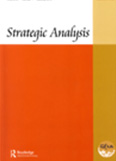The China–Pakistan axis: Asia’s new geopolitics by Andrew Small
‘“It is a little naive to think that the trouble with China was essentially due to a dispute over some territories. It had deeper reasons.”—Jawaharlal Nehru’ (p. 68).
‘“China has a good understanding of almost everything in Pakistan, political security or economic, that might affect the bilateral relationship, but there is one piece they just don’t get: Islam”—Pakistani Sinologist, Islamabad’ (p. 81).
- Satyam Malaviya
- March 2016
- Strategic Analysis








